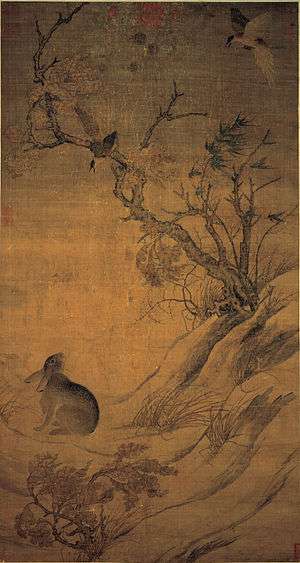Cui Bai
Cui Bai (Chinese: 崔白; pinyin: Cuī Bái; Wade–Giles: Ts'ui Po, also known as Cui Bo, style name Zixi (子西)) (fl. 1050–1080)[1] was a prominent Chinese painter of the Northern Song Dynasty (960–1279). A native of Anhui Province,[2] Cui was best known for paintings of animals and plants. At some point during his life, he traveled to the capital of Kaifeng to seek employment as a court artist, and was accepted by Emperor Shenzong of Song, who admired his works. He became a renowned artist of Shenzong's court, but gained an awkward reputation for his often eccentric behavior.

| Wikimedia Commons has media related to Cui Bai. |
Cui Bai is today known for two paintings depicting magpies and sparrows respectively. Magpies and Hare, also known as "Double Happiness", because "two magpies" in Mandarin Chinese is pronounced the same as "two happinesses", is held in the National Palace Museum, Taipei. The painting would have been meant as a gift to someone to congratulate them in some way, most likely for a wedding. Wintery Sparrow, a large handscroll, is kept in the Palace Museum in Beijing.
Notes
- Barnhart: Page 372.
- Ci Hai: Page 792.
References
- Barnhart, R. M. et al. (1997). Three thousand years of Chinese painting. New Haven, Yale University Press. ISBN 0-300-07013-6
- Ci hai bian ji wei yuan hui (辞海编辑委员会). Ci hai (辞海). Shanghai: Shanghai ci shu chu ban she (上海辞书出版社), 1979.
See also
- Culture of the Song Dynasty
